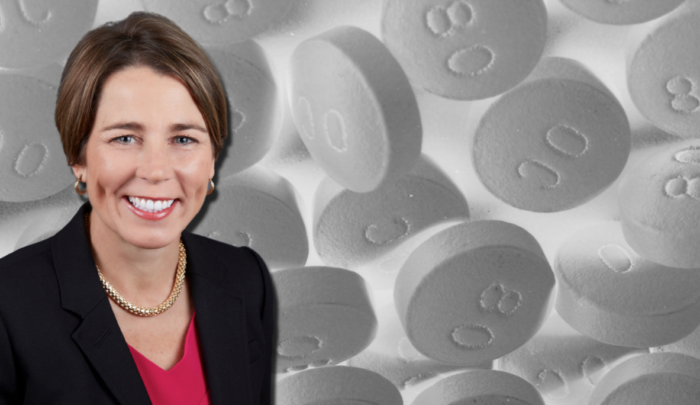
AG looks to extract more from Purdue Pharma, which is now in the recovery drug biz.
LOCAL
Outgoing Boston Mayor Marty Walsh is finally on his way to become labor secretary. So at this point, it’s safe to say that he was never able to settle the first major crisis of his seven-year stint running the city.
In October 2014, with about 10 months on the job, Walsh ordered the sudden closure of the bridge that connects Long Island to Quincy’s shore, as well as the closure of the major homeless shelter and substance use disorder treatment programs that had existed for years on the island.
In fairness to Walsh, the City of Quincy has blocked efforts to rebuild the bridge from the beginning. Walsh pledged in May 2018 that construction on the bridge would begin in 2019; in a 2015 press release, the mayor estimated that the bridge could possibly be completed in 24-36 months “if expedited given emergency circumstances.”
Despite state regulators signing off on Boston’s plan to reduce environmental damage in the harbor, the Quincy Conservation Commission denied a permit based on unproven environmental impacts. That city’s Mayor Thomas Koch told an NECN reporter in 2018 that his intention was to block construction of the bridge, which is referenced in a lawsuit the City of Boston filed against the conservation commission in November 2018. It took until February 2021 before the judge ruled in favor of Boston, reversing the conservation commission’s denial.
Construction cannot start while there is active litigation, which is still the case, since Quincy filed their appeal of the ruling on March 16. Win or lose, the appeal will further delay construction for months.
Meanwhile, according to city data, there have been more than 1,000 opioid deaths in Boston since the closure of Long Island.
“Boston is focused on creating a regional recovery campus on Long Island, guided by our fundamental belief that every person deserves a chance at recovery,” Walsh spokesperson Nick Martin said. “Rebuilding the Long Island Bridge is necessary for opening that campus. That bridge carried the weight of those in need for more than 60 years, and it’s our hope that the island will once again serve as the sanctuary that it’s meant to be.”
STATE
State Attorney General Maura Healey took to the USA Today opinions page on March 16 to criticize the bankruptcy plan for Purdue Pharma—the OxyContin giant that spent the last quarter of a century pushing opioids across the country, including in the Bay State.
“I am demanding that Purdue amend their plan,” Healey said during a Facebook address on March 16. “They pocketed so many billions from OxyContin that they can sit back and watch investment returns of hundreds of millions of dollars each year. This plan lets the Sacklers off the hook.”
Healey sued the Sackler family and Purdue Pharma in Suffolk Superior Court in June 2018, but that case was put on hold in October 2019 after Purdue filed for bankruptcy.
Aside from her op-ed in a national newspaper, Healey repeatedly spoke out against Trump during his presidency, all of which helps politically position the AG for higher office. A cynic might suggest that she was waiting for a senatorial run in the event that Sen. Elizabeth Warren happens to leave office for a Biden appointment.
Considering her recent photo ops in Brockton and Randolph and the fact that she has about a full year before she even has to announce, perhaps Healey’s sights are set on the governor’s office in 2022.
NATIONAL
Speaking of Purdue Pharma, the addiction grift disguised as a legitimate corporation hopes to come out of this whole controversy as a rebranded company under new ownership with a renewed source of income.
As thousands of towns, counties, and states sued the pharmaceutical behemoth over the last few years, Purdue Pharma filed for bankruptcy as a means to avoid having to pay out the full amount from the lawsuits. Instead, the Sacklers are banking on a bailout of sorts, where they use a portion of their fortune to settle out of court.
Forbes estimated in 2016 that the net worth of the Sacklers was at about $14 billion. The family would contribute about $4.3 billion, but those payments would be stretched over a decade, which enables the drug moguls to live off of the investment interest on the money that should be earmarked for reparations.
As for its plan, Purdue Pharma aims to transform into another company that continues to sell OxyContin, but will now also specialize in addiction treatment drugs. The Sacklers have promoted the idea, which would have to be approved by the thousands of town and state governments suing the company, that an additional $4 billion will go to the public, but in the form of discounts for the treatment drugs that are needed in part because they made a mint by promoting addiction. [Ed. note: Check digboston.com for some of the only critical reporting in this area to date on the dangers of treatment drugs like Suboxone.]
Zack is a veteran reporter. He writes for DigBoston and VICE, and formerly reported for the Boston Courant and Bulletin Newspapers.

